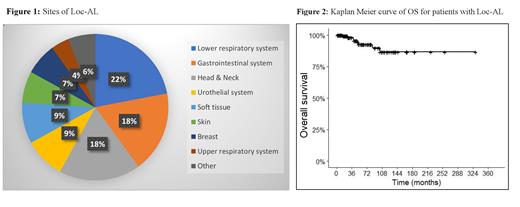Introduction : Localized immunoglobulin light chain amyloidosis (Loc-AL) is an ultra-rare disease caused by the local deposition of misfolded AL fibrils. To date, limited data exists on reporting patterns of disease presentation and long-term outcomes. The primary aim of this study is to describe our institution's experience of patients with Loc-AL, including disease presentation, management, and risk for local and systemic progression.
Methods: We retrospectively analyzed medical records of 3108 patients with amyloidosis and selected 141 (5%) patients with biopsy proven Loc-AL treated at our institution between 1/1/2010 and 7/1/2023. Patients with evidence of systemic AL disease involving the bone marrow and/or major organs, such as heart, kidney, liver, and nervous system on initial assessment were excluded. AL amyloid typing was available in all cases; mass spectrometry was performed in 85 (60%) cases. Chi-squared test and Kaplan-Meier method were used for statistical analysis.
Results: Of the 141 patients with Loc-AL included in this analysis, 79 (56%) were female and 117 (83%) were White. The median age at diagnosis was 67 (range 18-92) years. The sites of involvement included: 22% lower respiratory system (16% lung/pleura, 4% tracheobronchial system, 2% multi-site), 18% gastrointestinal system (8% upper GI [esophagus, stomach, duodenum] tract, 9% lower GI [colon, rectum] tract, and 1% other), 18% head & neck (eye [conjunctiva, lacrimal sac], auditory canal, oral cavity, pharynx/oropharynx), 9% urothelial system (prostate, bladder, ureteral, urethra), 9% soft tissue, 7% skin, 7% breast, 4% upper respiratory system (vocal cords, larynx, subglottic area), and 6% others (including two cases of central nervous system involvement) (Figure 1). At presentation, 75 (53%) patients were symptomatic, whereas in the remaining 65 (47%) patients Loc-AL was an incidental finding. Bone marrow biopsy, fat pad biopsy and cardiac imaging (echocardiogram and/or cardiac MRI) were obtained in 67 (48%), 20 (14%) and 105 (74%) patients, respectively. All bone marrow and pad biopsies were negative for AL amyloid; in addition, no bone marrow biopsy revealed monoclonal plasma cells. A serum monoclonal protein (sMP) was detected in only 29 (20%) patients, 12 of whom had serum light chain different from the localized light chain type. Of the 29 patients with positive sMP, 20 had IgG isotype, 6 had IgM, 2 IgA and 1 had light chains only. Abnormal free light chain ratio was reported in 17 (12%) patients, 6 of whom had a positive sMP. Twenty-four (17%) patients had coexistent autoimmune disease and 13 (9%) co-existent malignancy that was not plasma cell related. First line management approaches included: observation with or without supportive care (57%), surgical resection (38%), radiotherapy (2%), systemic therapy (3.5% chemotherapy, 3.5% steroids) and topical therapy (3.5%). Of the 5 patients who received chemotherapy, 4 had plasma cell-directed therapy; of them, 3 maintained stable disease based on follow-up imaging and 1 had no response. The fifth patient received rituximab for their underlying MALT lymphoma. Seventeen patients (12%) required repeated interventions (median 1 [range 1-4]) for local disease progression. The most common sites requiring repeated interventions were: genitourinary system (29%), respiratory system (24%) and breast (18%). No patient progressed to systemic AL. There were no deaths attributed to Loc-AL. The median follow-up time was 46.7 months. The 2- and 5-year local progression free survival rates were 93%, and 78%, respectively, and there was no difference with regard to site of disease. The estimated median overall survival (OS) was not reached; the 2- and 5-year OS rates were 99% and 92%, respectively (Figure 2).
Conclusion: The results of our study suggest thatLoc-AL has an excellent prognosis, and does not progress to systemic AL disease. A significant number of patients have no symptoms at diagnosis. Observation and/or surgical removal are usually adequate initial approaches to manage Loc-AL, however, a small percentage of patients can relapse locally requiring repeated interventions for symptom control. Consultation with a hematologist is important to rule out systemic disease.
Disclosures
Williams:Bristol Meyers Squibb: Consultancy; Abbvie: Consultancy; Janssen: Consultancy. Valent:Alexion, AstraZeneca Rare Disease: Research Funding. Khouri:Janssen: Consultancy, Membership on an entity's Board of Directors or advisory committees, Other: Payment or honoraria for lectures, presentations, speakers bureaus, manuscript writing or educational events; GPCR Therapeutics: Other: Payment or honoraria for lectures, presentations, speakers bureaus, manuscript writing or educational events. Raza:Prothena: Honoraria; Pfizer: Honoraria; Kite Pharma: Honoraria; Autolus Therapeutics: Current holder of stock options in a privately-held company; ATARA Therapeutics: Current holder of stock options in a privately-held company.


This feature is available to Subscribers Only
Sign In or Create an Account Close Modal